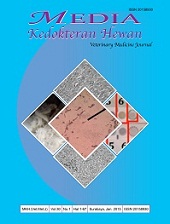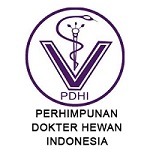Prophylaxic study of Combination Ethyl Acetate Fraction of Andrographis paniculata Ness. and Dihidroartemisinin-Piperaquine (DHP) in Malarial Infected Mice
Downloads
The resistance to some antimalarial drugs has had a major impact on the drug selection for malaria prophylaxis. According to previous research, the combination of Andrographis paniculata and Dihydroartemisinin-piperaquine (DHP) can prevent artemisinin resistance, reduce the adverse effects and is highly effective as an antimalarial. This study aims to determine the malaria prophylactic activity and survival time of the combination of A. paniculata ethyl acetate fraction with DHP on P. berghei infected mice. An in vivo malaria prophylaxis study was conducted based on Peters’ prophylactic test method. The combination of A. paniculata ethyl acetate fraction at a dose of 100 mg andrographolide/kg BW was administered twice a day per oral for four days and continued for another day after infection, meanwhile DHP at a dose 1,6 mg/kg BW was administered once a day per oral for three days. These results show that the combination of A. paniculata ethyl acetate fraction with DHP can inhibit 54,35% of the malaria parasite on day 4 and 44,98% on day 5, which was less active than the monotherapy group of A. paniculata ethyl acetate fraction or DHP alone. Also, this combination can increase the survival time of the mice to 6 days.
Chatio, S., Aborigo, R., Adongo, P. B., Anyorigiya, T., Dalinjong, P. A., Akweongo, P., Oduro, A. (2016). Factors influencing adverse events reporting within the health care system: the case of artemisinin-based combination treatments in northern Ghana. Malaria Journal; 15: 125. doi: https://doi.org/10.1186/s12936-016-1172-2.
Chotsiri, P., Zongo, I., Milligan, P., Compaore, Y. D., Somé, A. F., Chandramohan, D., Hanpithakpong, W., Nosten, F., Greenwood, B., Rosenthal, P. J., White, N. J., Ouédraogo, J. B., Tarning, J. (2019) Optimal dosing of dihydroartemisinin-piperaquine for seasonal malaria chemoprevention in young children. Nature Communications; 10(1): 480. doi: 10.1038/s41467-019-08297-9.
Erhirhie, E. O., Ikegbune, C., Okeke, A. I., Onwuzuligbo, C. C., Madubuogwu, N. U., Chukwudulue, U. M., Okonkwo O. B. (2021). Antimalarial herbal drugs: a review of their interactions with conventional antimalarial drugs. Clinical Phytoscience; 7(4). https://doi.org/10.1186/s40816-020-00242-4
Hafid, A. F., Rifai, B., Tumewu, L., Widiastuti, E., Dachliyati L., Primaharinastiti, R., Widyawaruyanti, A. (2015). Andrographolide Determination of Andrographis paniculata Extracts, Ethyl Acetate Fractions and Tablets by Thin Layer Chromatography. Journal of Chemical and Pharmaceutical Research, 7(12): 557-561.
Jarukamjorna, K. and Nemotob, N. (2008). Pharmacological Aspects of Andrographis paniculata on Health and Its Major Diterpenoid Constituent Andrographolide. Journal of Health Science; 54(4): 370–381. doi: 10.1248/jhs.54.370.
Kementerian Kesehatan Indonesia. (2022). Data Malaria di Indonesia. National Strategic Plan Malaria. https://malaria.id/laporan. Accessed: 23 July 2023.
Okhuarobo, A., Ehizogie Falodun, J., Erharuyi, O., Imieje, V., Falodun, A., & Langer, P. 2014. Harnessing the medicinal properties of Andrographis paniculata for diseases and beyond: a review of its phytochemistry and pharmacology. Asian Pacific Journal of Tropical Disease; 4(3): 213–222. doi: 10.1016/S2222-1808(14)60509-0.
Palleria, C., Di Paolo, A., Giofrè, C., Caglioti, C., Leuzzi, G., Siniscalchi, A., De Sarro, G., Gallelli, L. (2013) Pharmacokinetic drug-drug interaction and their implication in clinical management. Journal of Research in Medical Sciences; 18(7): 601-610.
Panossian, A., Hovhannisyan, A., Mamikonyan, G., Abrahamian, H., Hambardzumyan, E., Gabrielian, E., Goukasova, G., Wikman, G., Wagner, H. (2000). Pharmacokinetic and oral bioavailability of andrographolide from Andrographis paniculata fixed combination Kan Jang in rats and human. Phytomedicine. 7(5): 351-364. doi: 10.1016/S0944-7113(00)80054-9.
Savitz, D. A. and Styka, A. N. (2020). Board on Population Health and Public Health Practice, Health and Medicine Division, and National Academies of Sciences, Engineering, and Medicine. Assessment of Long-Term Health Effects of Antimalarial Drugs When Used for Prophylaxis. Washington, D.C.: National Academies Press. doi: 10.17226/25688
Solomon Jeeva, J. J. (2014). Andrographis paniculata: A Review of its Traditional Uses, Phytochemistry and Pharmacology. Medicinal & Aromatic Plant; 03(04). doi:10.4172/2167-0412.1000169.
Suryawati, S. (1995). Efek Samping Obat Edisi kedua. Pusat Studi Farmakologi Klinik dan Kebijakan Obat UGM, PT. Karipata, Yogyakarta; 245-270.
Widyawaruyanti, A., Astrianto, D., Ilmi, H., Tumewu, L., Setyawan, D., Widiastuti, E., Dachliyati, L., Tantular, I. S., Hafid, A. F. (2017). Anti-malarial activity and survival time of A. paniculata fraction. (AS202-01) on Plasmodium berghei infected mice. Res J Pharmaceut Biol Chem Sci; 8(1S): 49–54.
Widyawaruyanti, A., Bastiana, Ilmi, H., Tumewu, L., Prasetyo, B., Hafid, A. F., Aryati. A Tablet Derived from Andrographis paniculata Complements Dihydroartemisinin-Piperaquine Treatment of Malaria in Pregnant Mice. Journal of Basic and Clinical Physiology and Pharmacology; 33(2): 175-183. doi: 10.1515/jbcpp-2020-0162.
Copyright (c) 2025 Hanifah Khairun Nisa, Aviatus Solikhah, Hani Plumeriastuti

This work is licensed under a Creative Commons Attribution-ShareAlike 4.0 International License.

Veterinary Medicine Journal by Unair is licensed under a Creative Commons Attribution-ShareAlike 4.0 International License.
1. The Journal allows the author to hold the copyright of the article without restrictions.
2. The Journal allows the author(s) to retain publishing rights without restrictions
3. The legal formal aspect of journal publication accessibility refers to Creative Commons Attribution Share-Alike (CC BY-SA).





11.jpg)







11.png)













